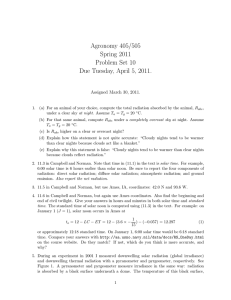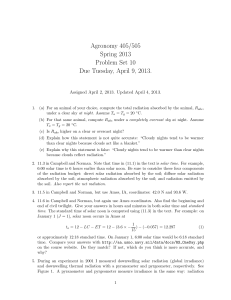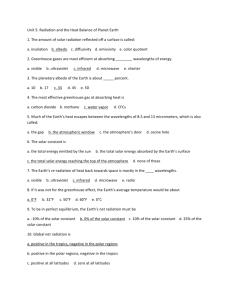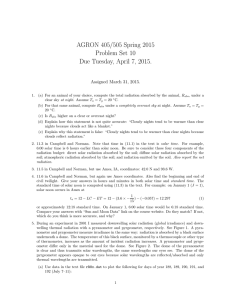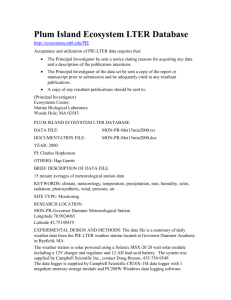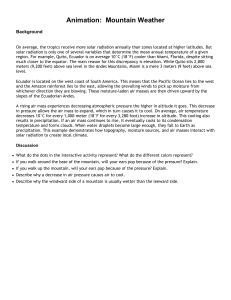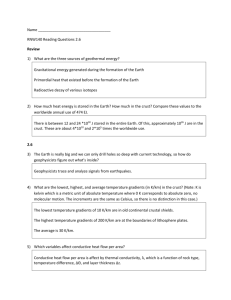Agronomy 405/505 Spring 2009 Problem Set 10 Due Tuesday, April 7, 2009
advertisement
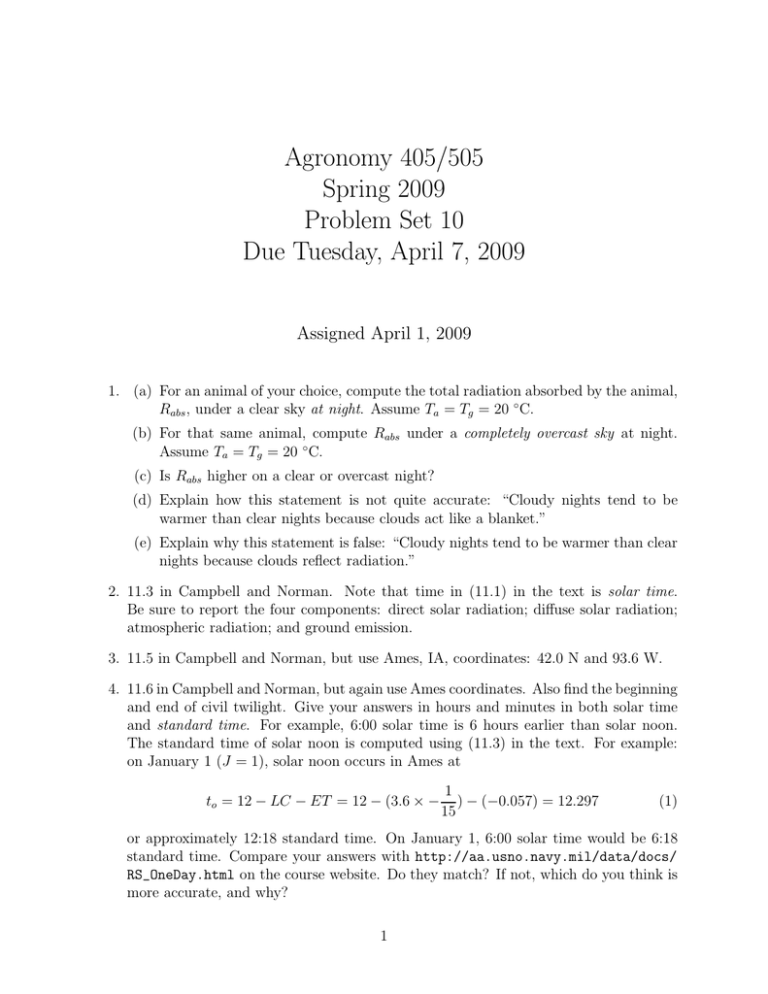
Agronomy 405/505 Spring 2009 Problem Set 10 Due Tuesday, April 7, 2009 Assigned April 1, 2009 1. (a) For an animal of your choice, compute the total radiation absorbed by the animal, Rabs , under a clear sky at night. Assume Ta = Tg = 20 ◦ C. (b) For that same animal, compute Rabs under a completely overcast sky at night. Assume Ta = Tg = 20 ◦ C. (c) Is Rabs higher on a clear or overcast night? (d) Explain how this statement is not quite accurate: “Cloudy nights tend to be warmer than clear nights because clouds act like a blanket.” (e) Explain why this statement is false: “Cloudy nights tend to be warmer than clear nights because clouds reflect radiation.” 2. 11.3 in Campbell and Norman. Note that time in (11.1) in the text is solar time. Be sure to report the four components: direct solar radiation; diffuse solar radiation; atmospheric radiation; and ground emission. 3. 11.5 in Campbell and Norman, but use Ames, IA, coordinates: 42.0 N and 93.6 W. 4. 11.6 in Campbell and Norman, but again use Ames coordinates. Also find the beginning and end of civil twilight. Give your answers in hours and minutes in both solar time and standard time. For example, 6:00 solar time is 6 hours earlier than solar noon. The standard time of solar noon is computed using (11.3) in the text. For example: on January 1 (J = 1), solar noon occurs in Ames at to = 12 − LC − ET = 12 − (3.6 × − 1 ) − (−0.057) = 12.297 15 (1) or approximately 12:18 standard time. On January 1, 6:00 solar time would be 6:18 standard time. Compare your answers with http://aa.usno.navy.mil/data/docs/ RS_OneDay.html on the course website. Do they match? If not, which do you think is more accurate, and why? 1 5. During an experiment in 2001 I measured downwelling solar radiation (global irradiance) and downwelling thermal radiation with a pyranometer and pyrgeometer, respectively. See Figure 1. A pyranometer and pyrgeometer measure irradiance in the same way: radiation is absorbed by a black surface underneath a dome. The temperature of this black surface, monitored by a thermocouple or other type of thermometer, increases as the amount of incident radiation increases. A pyranometer and pyrgeometer differ only in the material used for the dome. See Figure 2. The dome of the pyranometer is clear and thus transmits solar wavelengths, the same wavelengths our eyes see. The dome of the pyrgeometer appears opaque to our eyes because solar wavelengths are reflected/absorbed and only thermal wavelengths are transmitted. (a) Use data in either the text file “rR8x.dat” (suitable for use in Excel or similar program) or the m–file “rR8x.mat” (both available on the website) to plot the net radiation at the top of the vegetation canopy for days of year 190, 191, and 192 (July 9–11): 4 Rn = S + A − aS + σ Tveg . (2) Here S = the downwelling solar radiation, A = the downwelling thermal radiation, a is the albedo of the vegetation canopy, and Tveg is the temperature at the top of the vegetation canopy. Read the comments in “rR8x.dat” to determine which variables to use. Note that we are assuming a thermal emissivity of unity for the vegetation canopy. (b) During what period of the day (approximately) is the net radiation positive? (c) What happens to the energy associated with the positive net radiation? (d) During what period of the day (approximately) is the net radiation negative? (e) What is happening (physically) when the net radiation is negative? If interested (you don’t have to do this, it’s only for fun), plot the four components of Rn and see how they each vary over time. 6. Read the Nature article “Saving Time” at http://www.nature.com/nature/journal/ v445/n7126/pdf/445344a.pdf. (a) What did the British parliament consider on 26 January, 2007? (b) What two large countries do not observe daylight saving time? (c) According Elizabeth Garnsey, even if there is not much benefit to the proposal, what will the three–year experiment at least provide? (d) Can you think of any other strategies, besides actually changing the clocks, that would encourage people to be more active during normal daylight hours and hence use less energy? The vote on 26 January, 2007, failed. London is still on GMT, with an hour jump during the summer. 2 Figure 1: Micro–meteorological tower in Southeastern Michigan, July, 2001. A pyranometer and pyrgeometer are situated on the end of the long arms. Figure 2: A pyranometer (left) and pyrgeometer (right). 3
